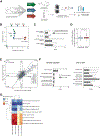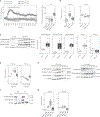Food Perception Primes Hepatic ER Homeostasis via Melanocortin-Dependent Control of mTOR Activation
- PMID: 30445039
- PMCID: PMC6541012
- DOI: 10.1016/j.cell.2018.10.015
Food Perception Primes Hepatic ER Homeostasis via Melanocortin-Dependent Control of mTOR Activation
Abstract
Adaptation of liver to the postprandial state requires coordinated regulation of protein synthesis and folding aligned with changes in lipid metabolism. Here we demonstrate that sensory food perception is sufficient to elicit early activation of hepatic mTOR signaling, Xbp1 splicing, increased expression of ER-stress genes, and phosphatidylcholine synthesis, which translate into a rapid morphological ER remodeling. These responses overlap with those activated during refeeding, where they are maintained and constantly increased upon nutrient supply. Sensory food perception activates POMC neurons in the hypothalamus, optogenetic activation of POMC neurons activates hepatic mTOR signaling and Xbp1 splicing, whereas lack of MC4R expression attenuates these responses to sensory food perception. Chemogenetic POMC-neuron activation promotes sympathetic nerve activity (SNA) subserving the liver, and norepinephrine evokes the same responses in hepatocytes in vitro and in liver in vivo as observed upon sensory food perception. Collectively, our experiments unravel that sensory food perception coordinately primes postprandial liver ER adaption through a melanocortin-SNA-mTOR-Xbp1s axis. VIDEO ABSTRACT.
Copyright © 2018 Elsevier Inc. All rights reserved.
Conflict of interest statement
DECLARATION OF INTERESTS
The authors declare no competing interests.
Figures







Comment in
-
Food perception primes the liver for metabolic adaptation.Nat Rev Gastroenterol Hepatol. 2019 Jan;16(1):4. doi: 10.1038/s41575-018-0098-2. Nat Rev Gastroenterol Hepatol. 2019. PMID: 30532062 No abstract available.
References
-
- Ahrén B, and Holst JJ (2001). The cephalic insulin response to meal ingestion in humans is dependent on both cholinergic and noncholinergic mechanisms and is important for postprandial glycemia. Diabetes 50, 1030–1038. - PubMed
-
- Balch WE, Morimoto RI, Dillin A, and Kelly JW (2008). Adapting proteo-stasis for disease intervention. Science 319, 916–919. - PubMed
-
- Balthasar N, Coppari R, McMinn J, Liu SM, Lee CE, Tang V, Kenny CD, McGovern RA, Chua SC Jr., Elmquist JK, and Lowell BB (2004). Leptin receptor signaling in POMC neurons is required for normal body weight homeostasis. Neuron 42, 983–991. - PubMed
-
- Belgardt BF, and Brüning JC (2010). CNS leptin and insulin action in the control of energy homeostasis. Ann. N Y Acad. Sci. 1212, 97–113. - PubMed
Publication types
MeSH terms
Substances
Grants and funding
LinkOut - more resources
Full Text Sources
Other Literature Sources
Molecular Biology Databases
Research Materials
Miscellaneous

